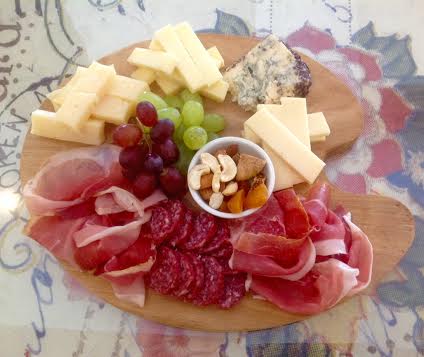
Two weeks ago, I indulged in a selection of cured meats and cheeses with wine, all from Italy, specially picked by Adriano Steffanuti of Massimo Trulli Fashion, Food & Wine Concept Store.
Arranged neatly on the wooden board were Speck di Sauris (Friuli)— dry cured, lightly smoked prosciutto that was exquisite to the bite. It was aromatic, bold on the palate yet refined on the finish. The ham was tasty, moist, tender and not a tinge too salty.
Add to that the equally exquisite rose-tinged Prosciutto San Daniele (Friuli), with a distinct nibble, sweet and delicate.
Easy to eat
Between the two hams, I had bites of Raspini’s Salamino Pelafacile (small, easy-to-peel salami). The salami from Piedmont is the uncomplicated kind and can be enjoyed simply by itself or with crusty bread.
With the meats came the cheeses, all made from cow’s milk. It was an interesting mix, from easy eats to more complex tasting types.
Montasio (Friuli) is a hard, mild cheese that can be enjoyed by cheese and noncheese lovers alike. It is easy to snack on; nice chew.
The Latteria di Grotta (Friuli) is also a hard cheese, but crumbly with an intense flavor and aroma, made distinct by its aging process. In the olden days, this type of cheese was wrapped in hay and left to mature in caves, thus its name “Grotta” (cave).
Latteria, meanwhile, means the dairy shop where milk—“latte”—is processed.
The hay’s purpose is to absorb the moisture. The unique flavor and taste of this cheese is developed through this particular process. Though no longer matured in caves, the Latteria di Grotta is still wrapped in hay while being aged.
The Blu Ramandolo is cheese covered with pomace from Ramandolo wine and aged in cellars. The combination of the pomace and the mold from the cheese is what makes it blue—a must-try.
Ideal pairing
I was also most impressed with the wine selection. The bottle of Refosco (produced by Collavini) beautifully paired with the meats and cheeses.
Refosco is both the name of the grape as well as the red wine produced from it. Collavini’s Refosco was subtle, rounded, fresh, easy to drink and completely cleanses the palate after every bite, from one type of meat or cheese to the next.
The Italian red wine from Friuli has a tinge of sweetness that complements the cured meats and cheeses; the Blu Ramandolo, especially. A sip of the wine mellows the cheese, making the combination of both harmonious to the palate.
All these delicious Italian products are now available at Massimo Trulli Fashion, Food & Wine Concept Store.
At Massimo Trulli, diners enjoy the luxury of Italian designer Massimo Trulli’s home pieces, such as chairs, sofas and tables.
The cellar also has an interesting collection of Italian high-end wines that will impress aficionados.
Massimo Trulli Fashion, Food & Wine Concept Store is at LRI Design Plaza, 210 Nicanor Garcia, Bel-Air II, Makati City; tel. 8329600 and 0915-4181407.
Chocolate bars with a Pinoy twist
This week, I tried interesting chocolates by Theo & Philo.
The turon variety was quite a treat—creamy milk chocolate with fruity-chewy banana bits, a sprinkling of crispy caramel and roasted sesame seeds, all of which gave it depth and nuttiness. Its texture was a delight. It’s a well-conceived, well-executed bar.
Another bar from the collection that I fancied was the barako. It’s the perfect shot of espresso in a milk chocolate bar that perks you up at first bite. Once you sink your teeth into the chocolate, the barako comes alive, tingling the buds and awakening the palate.
These ingenious chocolate creations with a Pinoy touch are the brainchild of Philo Chua, who learned how to cook while working in Information Technology in the United States.
After a few years, he decided to come home and start a business—he wasn’t certain what kind, but it had to be food-related.
He was later inspired by a shop in Pittsburgh that sold gourmet chocolates from around the world. The trend at that time was “single-origin” chocolates, which meant that the cacao bean used in the chocolate must come from just one locale.
Chua knew there’s cacao in the Philippines. He did his research, then came home to pursue his dream of making his own single-origin chocolate bars.
Special flavors
In the beginning, his company produced only 70-percent dark and plain milk chocolates; then he slowly concocted special flavors for the holidays.
“We focused on what was unique to us and also what was in line with our concept of Philippine single-origin chocolates. So we decided to go with Filipino flavors,” says Chua.
He kept to safe flavors in the beginning, adapting classic flavors but giving them a native twist. The chocolate with calamansi was a take on the chocolate with orange; the chocolate and chili he translated into chocolate with labuyo.
But over time, Chua has become bolder, creating variants such as adobo and green mango and salt.
I learned that there is more to him than just his love for chocolates. Every fancy flavored chocolate bar he makes is made even more special by the advocacies he supports, such as employing the less fortunate without requiring previous experience, awarding scholarships, assisting the farmers they work with to secure equipment and using local ingredients whenever possible.
The brand Theo & Philo means “chocolate and love” or lover of chocolate. “Theo” comes from Theobroma cacao, the scientific name of the cacao plant. “Philo” is the Greek word for love. Amazingly, whether coincidence or not, it’s Chua’s first name, too.
Theo & Philo, tel. 6311362 and 0920-4315650.
For a copy of my latest cooking class schedule, call 0908-2372346 or 0917- 5543700.








































